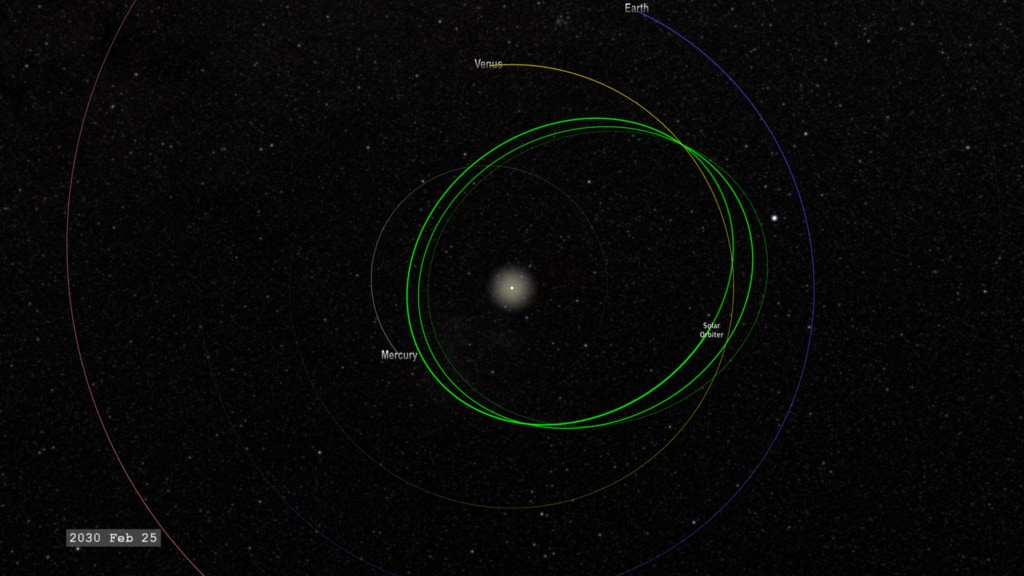
Orbiter will also complete its only planned flyby of Earth.

November, 2021: Initial cruise phase of the mission ends. It will make several more throughout its mission.

December, 2020: Solar Orbiter makes its first flyby of Venus. Here's a timeline of the mission: February 9, 2020: An Atlas V 411 rocket will launch the Solar Orbiter from SLC-41 atCape Canaveral Air Force Station in Florida. The Solar Orbiter will travel in an elliptical orbit around the Sun, completing one orbit every 168 days.

Passages near Venus will gradually change the inclination of Solar Orbiter’s path, gradually giving us views of the elusive polar regions of the Sun.Engineers at the IABG facility in Ottobrunn, Germany getting the orbiter ready for launch. Solar Orbiter just reached its closest perihelion yet this past weekend, passing 50 million kilometers from the Sun interior to the orbit of Mercury. The United Launch Alliance Atlas V rocket carrying the Solar Orbiter lifts off Space Launch Complex 41 at Cape Canaveral Air Force Station. The mission comes at an auspicious time, as Solar Cycle 25 gets underway in earnest this year, en route to its peak around 2025, which may be one of the most powerful in decades. Launched on February 10 th, 2020 atop an Atlas V rocket from Cape Canaveral Space Force (at the time, Air Force) Station, Solar Orbiter has a primary seven year mission to study the Sun. Solar Orbiter: taking the temperature of the Sun. The SPICE sequence in particular shows temperature layers in color versus elemental composition: yellow (neon) at 630,000 degrees Celsius, green (oxygen) at 320,000 degrees Celsius, blue (carbon) 32,000 degrees Celsius, and purple (hydrogen) at a ‘cool’ 10,000 degrees Celsius. SPICE’s temperature view of the Sun: one layer at a time. You’d think that the Sun gets cooler, out through successive layers farther out… but the reverse is actually the case, as the outer corona reaches a million degrees versus the surface of the photosphere, at a relatively cool 5,000 degrees Celsius. Solar Orbiter observations will address the key question of how eruptions are born on the surface of the Sun, by characterizing the temperature of the Sun seen through successive layers. The image includes filaments, nano-flares and spicules seen across the roiling surface of the Sun.
#SOLAR ORBITER TRAJECTORY TV#
The final result is laid out in a 9148 by 9112 grid of 83 million pixels, with a resolution 10 times better than your 4K TV screen. The Sun was large enough (two degrees across) from that distance that EUI needed a mosaic of 25 images to cover the entire disc of the Sun. Solar Orbiter snapped these images over a 4-hour session, while the probe was 75 million kilometers from the Sun, interior to the orbit of Venus.
#SOLAR ORBITER TRAJECTORY FULL#
The full disk SPICE image captures the Sun at the Lyman-beta wavelength in the ultraviolet, and represents one of the first images of its kind taken in 50 years, since the solar observation experiments aboard Skylab. Click here for a full resolution zoomable view. It’s definitely worth a scroll through and zoom in: EUI full disc image of the Sun. The EUI image alone represents the highest full disk resolution image of the Sun, looking right down through and capturing the corona and outer solar atmosphere. The instruments used aboard the spacecraft included the Extreme Ultraviolet Imager (EUI) and the Spectral Imaging of the Coronal Environment (SPICE) imager.

“From this point on-wards, we are ‘entering the unknown,’ as far as Solar Orbiter’s observations of the Sun are concerned,” says Solar Orbiter Project Scientist Daniel Müller in a recent press release.


 0 kommentar(er)
0 kommentar(er)
